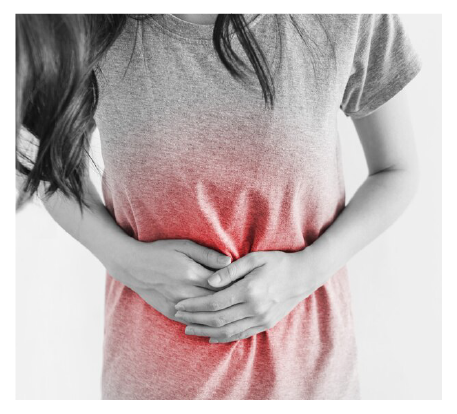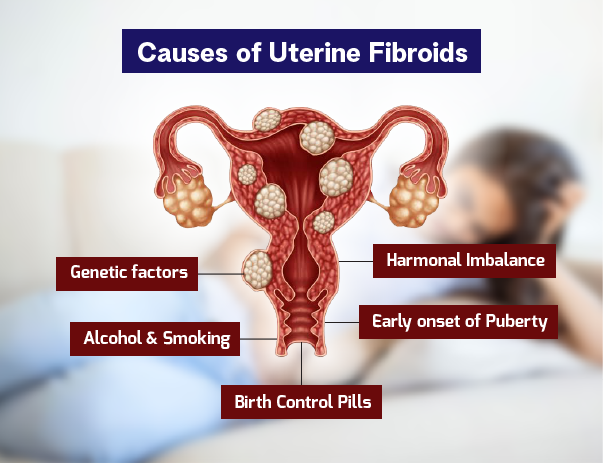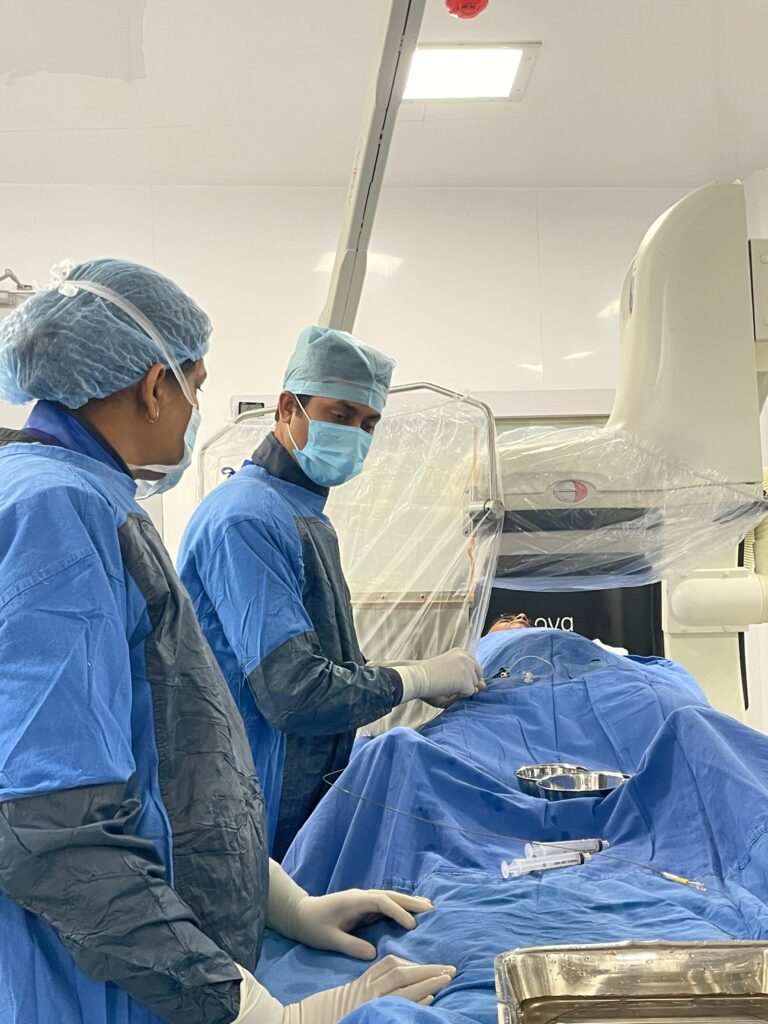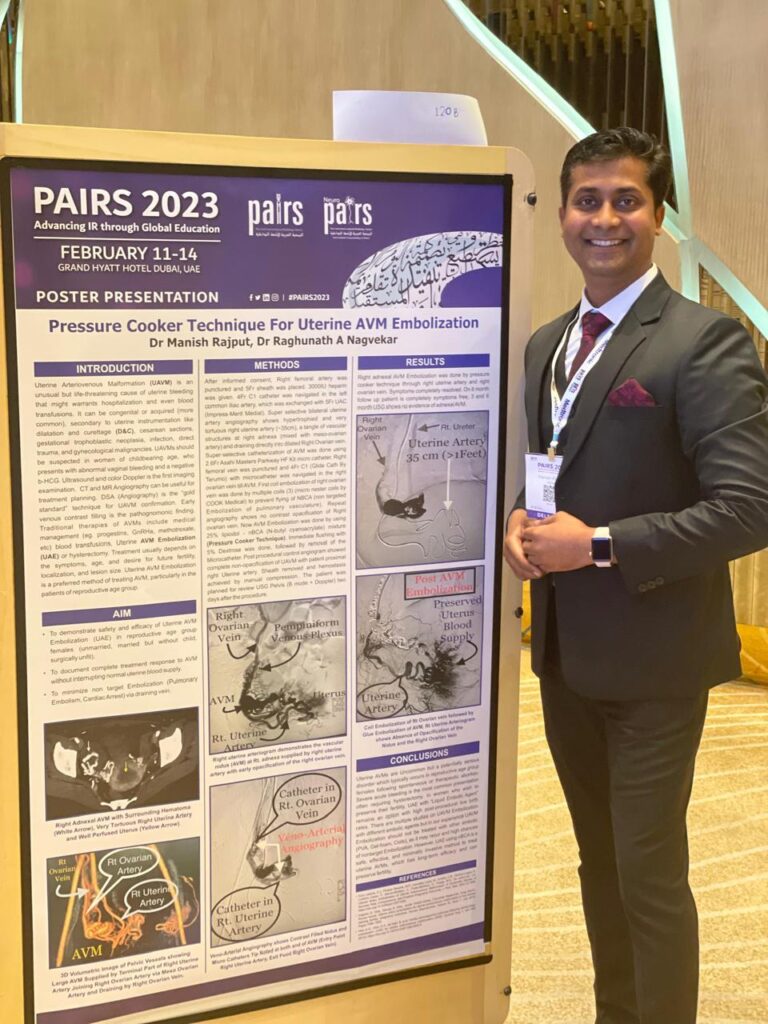Uterine Fibroids Embolization In Jaipur
Dr. Manish Rajput offers advanced Uterine Fibroid Embolization (UFE) treatment in Jaipur. This minimally invasive procedure helps women with uterine fibroids. It targets and shrinks fibroids, providing relief from discomfort. Patients can restore their quality of life with this effective solution.
What are Uterine Fibroids?
Fibroids are benign tumors. Benign means that they are not cancer.
Uterine fibroids occur in the muscle tissue of the wall of the uterus. They are not harmful, but they may be painful. They can also cause heavy menstrual bleeding or pressure on the bladder and bowel.
What is Uterine Fibroid Embolization?
In embolization, a doctor injects a material into a blood vessel to block blood flow. Uterine fibroid embolization (UFE) is a way to treat fibroids of the uterus without surgery.
UFE uses X-rays to guide a catheter (tiny tube) into the arteries that feed blood to the fibroid(s). Small particles are then injected to block blood flow.
UFE is done by an interventional radiologist, a doctor with special training to do this procedure. It is much easier on the body than open surgery, which uses a scalpel to make an incision in the body.

Symptoms of Uterine Fibroids
The symptoms of Uterine Fibroids can vary widely among individuals, often presenting a range of uncomfortable and sometimes distressing manifestations. These benign tumors, which develop in the muscular wall of the uterus, may lead to:
- Heavy Menstrual Bleeding
- Painful Menstrual Bleeding
- Female Infertility
- Recurrent Abortions
- Prolonged Menstruation
- Irritability/Depression
- Constipation
- Anemia
- Back/Pelvic Pain
- Frequent Urination
- Irregular Menses

Causes of Uterine Fibroids
Fibroids are also known as Leiomyomas. The causes of Uterine Fibroids can be multifactorial as:
- Genetic factors
- Harmonal Imbalance
- Birth Control Pills
- Obesity
- Alcohol & Smoking
- Early onset of Puberty
- Sedentary Lifestyle

Treatment Options for Uterine Fibroids
Treatment depends on severity of symptoms. Treatment ranges from conservative to surgical options such as:
- Hormon Therapy
- Surgical options
- Leproscopy
- Myomectomy
- Hysterectomy
- Interventional Radiology Treatments
- Uterine Fibroid Embolization/ Uterine Artery Embolization: UFE uses X-rays to guide a catheter (tiny tube) into the arteries that feed blood to the fibroid(s). Small particles are then injected to block blood flow which causes fibroids to shrink and later disappear.
- Microwave Ablation: A MWA electrode directly is inserted in the fibroid. It produces heat within the fibroid which results in tissue damage/ cell death which eventually results in shrinkage of fibroids.

Why Choose Dr. Manish Rajput For Uterine Fibroids Embolization Treatment in Jaipur?
Meet Our Expert
Dr. Manish Rajput
DNB, FVIR, PDCC, FRCR (Sch.)
Endovascular & Interventional Radiologist
When considering options for Uterine Fibroid Embolization in Jaipur, you may find yourself asking the crucial question: why should you choose Dr. Manish Rajput, a highly regarded specialist in this field? Dr. Rajput brings a wealth of experience and expertise to the table, having successfully treated numerous patients with uterine fibroids using this innovative, minimally invasive procedure.
His commitment to patient care is evident in his personalized approach, where he takes the time to thoroughly assess each individual’s unique medical history and needs. Furthermore, Dr. Rajput is known for utilizing the latest technology and techniques to ensure optimal outcomes while prioritizing patient comfort and safety.
With a strong track record of positive results and a compassionate demeanor, choosing Dr. Manish Rajput for your Uterine Fibroid Embolization Treatment in Jaipur may very well be one of the best decisions you make for your health.

Expertise
Dr. Manish Rajput is a highly skilled vascular specialist based in Jaipur, renowned for his extensive experience in treating varicose veins. His expertise guarantees that each patient receives personalized, top-notch care tailored to their specific needs.
Advanced Techniques
Dr. Rajput employs cutting-edge methods for treating Uterine Fibroids Embolization, including minimally invasive procedures such as endovenous laser Ablation (EVLA) and sclerotherapy.
Patient-Centric Care
Patients value Dr. Rajput's compassionate and patient-focused approach. He dedicates time to thoroughly explain treatment options, answer questions, and address concerns, ensuring that everyone feels at ease.
Proven Track Record
Dr. Manish Rajput, a leading Vascular and Interventional Radiologist in Jaipur, has a remarkable track record of successful outcomes in Uterine Fibroids Embolization treatment. His expertise has led many patients to experience substantial improvements in their vein health..
Expertise
Dr. Manish Rajput is a highly skilled vascular specialist based in Jaipur, renowned for his extensive experience in treating varicose veins. His expertise guarantees that each patient receives personalized, top-notch care tailored to their specific needs.
Advanced Techniques
Dr. Rajput employs cutting-edge methods for treating Uterine Fibroids Embolization, including minimally invasive procedures such as endovenous laser Ablation (EVLA) and sclerotherapy.
Patient-Centric Care
Patients value Dr. Rajput's compassionate and patient-focused approach. He dedicates time to thoroughly explain treatment options, answer questions, and address concerns, ensuring that everyone feels at ease.
Proven Track Record
Dr. Manish Rajput, a leading Vascular and Interventional Radiologist in Jaipur, has a remarkable track record of successful outcomes in Uterine Fibroids Embolization treatment. His expertise has led many patients to experience substantial improvements in their vein health..
Book An Appointment
What Patients Say
Uterine Fibroid Embolization Animation: A Quick Guide
Procedure
Patient Testimonial
Frequently Asked Question
Uterine fibroids are non-cancerous tumors that develop within the uterus. Commonly known as leiomyomas or myomas, these lesions can differ significantly in size, ranging from small, seed-like nodules to large, noticeable masses.
The precise etiology of uterine fibroids remains uncertain; however, various factors are thought to contribute to their formation. Hormonal imbalances, especially those involving estrogen and progesterone, are considered significant, as these hormones may promote the growth of fibroids. Genetic factors also play a role, given that fibroids frequently occur within families, indicating a possible hereditary link. Furthermore, factors such as age—particularly during the reproductive years—and specific lifestyle choices may affect the likelihood of developing fibroids. While the exact mechanisms are still under investigation, it is generally accepted that these interrelated factors contribute to the development and proliferation of uterine fibroids.
The manifestations of uterine fibroids may vary according to their size and positioning within the uterus. Common indicators include excessive menstrual bleeding, pelvic discomfort or pressure, increased frequency of urination, constipation, and pain in the lower back. The severity and effects of these symptoms can differ from person to person, influenced by the unique attributes of the fibroids.
The diagnosis of uterine fibroids typically entails a thorough methodology comprising an assessment of the patient’s medical history, conducting a pelvic examination, and employing imaging techniques. Frequently used imaging modalities include ultrasound, MRI, and CT scans, which facilitate the visualization of fibroids and aid in assessing their size and location.
Uterine fibroids are primarily noncancerous (benign) tumors. Although the overwhelming majority of fibroids are benign, there exists a minimal possibility that a fibroid may harbor malignant cells, leading to a condition termed leiomyosarcoma. This particular form of cancer is exceedingly uncommon, and the majority of women diagnosed with uterine fibroids do not have this type of malignancy.
Many uterine fibroids do not require treatment, especially when they are small and asymptomatic. In such cases, a physician may recommend routine observation to monitor the size of the fibroids and confirm that they are not leading to any complications.
